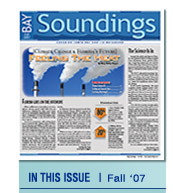 |
||||||||

EDITOR’S DESK
Chalk one up for Charlie
By signing executive orders on greenhouse gas reductions in July, Gov. Charlie Crist has joined a legion of Governors mobilizing for action on climate change, unwilling to wait any longer for federal guidance. The Governor has called global warming “one of the most important issues that we will face this century.”
Crist has become a rising star on the climate change circuit of late, sharing the stage in just the past few months with Arnold Schwarzenegger, Robert Redford and Bill Clinton. In July, California Gov. Schwarzenegger delivered the keynote address at the Florida Climate Change Summit, applauding our Governor for adopting California’s strict tailpipe emission standards. In early September, Crist headlined the Mayor’s Climate Summit in Sundance Utah, brushing elbows with the “Sundance Kid” himself, Robert Redford, who hailed Florida’s efforts to cut greenhouse gas emissions. Later that month, Crist joined Clinton and Florida Power & Light Company CEO Lew Hay at the Clinton Climate Change Summit in New York to announce the utility’s plans to build the world’s largest solar plant in Florida.
In a state where the stakes couldn’t be higher, Crist’s leadership on climate change is a breath of fresh air.
And the Nobel Prize goes to…
Former Vice President Al Gore and the U.N. Intergovernmental Panel on Climate Change won the Nobel Peace Prize October 12 for helping galvanize international action on global warming before it “moves beyond man’s control.”
In awarding the prize, the Nobel Committee said the case for action to halt global warming has been made convincingly by science.
“Whereas in the 1980s global warming seemed to be merely an interesting hypothesis, the 1990s produced firmer evidence in its support. In the last few years, the connections have become even clearer and the consequences still more apparent.”
Climate Change Series Continues
Bay Soundings will continue its series on Climate Change and Florida’s Future in its upcoming Winter 2008 issue, with stories on renewable energy sources, ethanol and climate change mitigation.
We welcome your comments as we continue exploring these critical issues.
— Mary Kelley Hoppe
| LETTER TO THE EDITOR: SWIM Celebrates 20 Years |
I want to thank you for yet another informative Bay Soundings. Having worked on several SWIM projects, it is fun to see the success this program has enjoyed for the last 20 years. I appreciate your editorial comments as this is truly a legacy program. |
| Bruce G. Hasbrouck, CEP President Florida Association of Environmental Professionals |
Legislators Call For “No Child Left Inside”
By Lara Lutz
Arguing that the leaders of tomorrow need to spend more time outdoors today, some lawmakers and conservation groups are calling for major changes in the nation’s approach to environmental education.
U.S. Sen. Jack Reed, D-RI, and U.S. Rep. John Sarbanes, D-MD, have introduced bills aimed at changing policies set by the No Child Left Behind Act, which is due for reauthorization by Congress later this year.
Their bill, dubbed the “No Child Left Inside Act,” would elevate the importance of environmental education and make approximately $100 million available to states that develop comprehensive plans for environmental literacy in public schools.
Many schools have scaled back or eliminated environmental education in order to focus on subjects that directly support student achievement on standardized tests.
“From saving the bay to confronting the challenges of climate change, we need to prepare the next generation to tackle and overcome some very complicated environmental challenges,” Reed said. “Teaching children about the world around them should be an important part of the curriculum in our schools.”
Supporters are hopeful that the proposed changes will be added to the No Child Left Behind Act, which is due to be reauthorized in 2007. The act outlines academic standards, focusing on standardized tests designed to chart the progress of both students and individual schools.
But the act has had unintended results. The drive for high test scores has often slashed time and funds for any subject not directly covered on the tests. Environmental education -- including quality outdoor experiences -- is one of them.
The proposed changes aim to give environmental education better standing. Both bills call for re-establishing an office of environmental education within the U.S. Department of Education. A handful of new and existing grant programs would make money available to help states and schools launch programs, develop curriculum and train teachers.
The money would only be available to states that develop and submit environmental literacy plans that address kindergarten through 12th grade.
The No Child Left Inside Coalition, made up of 14 conservation and education organizations, is heavily pushing the legislation. The Chesapeake Bay Foundation, National Education Association and National Science Teachers Association are among them. “At a time when the country has accepted that we have huge environmental issues facing us-like global warming and the links between the environment and energy policy, health policy and jobs-we’re seeing less environmental education in the classroom, not more,” said Don Baugh, the CBF’s director of education.
Advocates hope that the lure of funding will encourage states to develop environmental literacy plans and teachers to include environmental curriculum in their lessons. However, the proposed legislation falls short of requiring environmental content on standardized tests. That decision is left to individual states.
Pennsylvania began including the environment and ecology on its standardized tests in 2007. Patti Vathis, a curriculum advisor for the Pennsylvania Department of Education, said that the importance of testing should not be underestimated.
Environment and ecology are now among the top areas of focus for subjects that are tested in Pennsylvania, after reading, math and science technology. “If this field is going to move forward and succeed it has to be seen as a content area that will make a difference in children’s lives,” Vathis said.
Lara Lutz is a writer and editor who lives on the South River in Mayo, Maryland. Her column was reprinted with permission from the Chesapeake Bay Journal.

